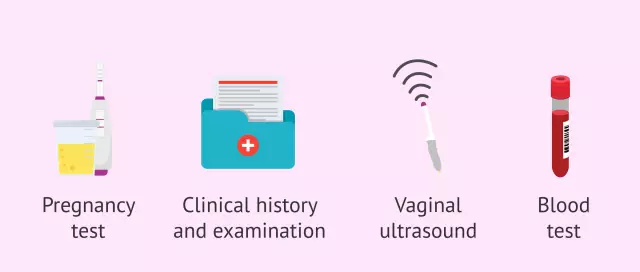- Author Rachel Wainwright [email protected].
- Public 2023-12-15 07:39.
- Last modified 2025-11-02 20:14.
Dysmenorrhea

Dysmenorrhea is a pathological process characterized by severe pain during menstruation, absent throughout the rest of the cycle. There are two types of disorders: primary dysmenorrhea and secondary dysmenorrhea. Primary dysmenorrhea is diagnosed in cases where the causes of painful menstruation are not identified. Dysmenorrhea develops in 45-60% of women of childbearing age. For the first time, dysmenorrhea can manifest itself in the first ovulatory menstrual cycle, significantly reducing the level of vitality and performance of a woman. Dysmenorrhea is more common in women with asthenic physique, prone to loss of consciousness, excitable. The disease is also typical for patients with vegetative-vascular dystonia and astheno-neurotic syndrome.
Primary dysmenorrhea
Primary dysmenorrhea is a functional disorder of the menstrual cycle, not caused by pathological processes in the pelvic organs. Primary dysmenorrhea develops in adolescence and can manifest itself both during the first menstrual cycle and 1-3 years after the onset of menstruation. As a rule, pains with such dysmenorrhea are tolerable; with age, painful sensations can increase. In accordance with the nature and severity of pain in primary dysmenorrhea, two forms are distinguished: compensated and uncompensated dysmenorrhea.
Compensated dysmenorrhea is characterized by unchanged painful sensations over time, while uncompensated dysmenorrhea is characterized by increasing pain over time. As a rule, with the second form of dysmenorrhea, patients cannot do without qualified medical care.
Pain with dysmenorrhea can appear 1-2 days before the expected menstruation, and also persist during the first days of the menstrual cycle. In most cases, with dysmenorrhea, pains are cramping, aching, pulling in nature. In rare cases, there are pains of a bursting nature, radiating to the rectum, the area of the bladder, and the appendages.
Secondary dysmenorrhea
Secondary dysmenorrhea is a pathological process caused by dysfunction of the pelvic organs, inflammatory processes, and gynecological diseases. Secondary dysmenorrhea is usually diagnosed in patients after 30 years. Secondary dysmenorrhea occurs in 27-33% of cases of the total number of diagnosed diseases, and has a more complex character. With secondary dysmenorrhea, the period of loss of the patient's performance is significantly increased. Painful sensations begin about a day before the expected menstruation. This type of dysmenorrhea is characterized by profuse menstrual bleeding with a large number of clots, severe pain in the lumbar region.
Dysmenorrhea: causes of the disease
In primary dysmenorrhea, the causes of the development of the disorder can be both physiological and psychological. In dysmenorrhea, the cause of painful sensations can be the production of PGE2 (prostaglandin E2) and PGE2-alpha (prostaglandin E2-alpha), which contribute to the contraction of smooth muscles and intensify painful sensations. In the primary form of dysmenorrhea, the reasons may lie in a violation of the hormonal background.
The psychological reason for the development and intensification of painful sensations with dysmenorrhea during menstruation is the patient's fear of pain. So, the very expectation of pain sharpens its perception.
With the secondary form of dysmenorrhea, the causes of the violation can be:
- Dilation of the pelvic veins;
- Inflammatory diseases of the pelvic organs;
- Tumors of the pelvic organs;
- Adhesions after surgery;
- Endometriosis;
- Dysplasia;
- Hormonal disorders in the body;
- Intrauterine device;
- Sexually transmitted diseases.
Dysmenorrhea: symptoms of disorder
Each of the forms of dysmenorrhea is characterized by a complex of symptoms, in accordance with which the diagnosis is made. In the primary form of dysmenorrhea, the symptoms manifest as follows:
- Pains of a different nature;
- Nausea, vomiting, dizziness, general weakness;
- Increased body temperature;
- Red spots on the skin of the hands, neck, face;
- Constipation;
- Violation of heart rhythms;
- Sleep disturbances, insomnia.
These symptoms of dysmenorrhea are caused by an increase in the level of the hormones adrenaline, dopamine, norepinephrine and determine the adrenergic type of dysmenorrhea.
Also, with dysmenorrhea, symptoms can be caused by an increase in the level of the hormone serotonin, which leads to:
- Decrease in heart rate;
- Vomiting, diarrhea;
- Decrease in body temperature.
These symptoms determine the parasympathetic type of dysmenorrhea.
With secondary dysmenorrhea, symptoms can be supplemented by symptoms of the underlying disease, which is the cause of painful periods.

In some cases, with dysmenorrhea, the symptom is painful intercourse.
Diagnosis of dysmenorrhea
The main methods for diagnosing dysmenorrhea are the clinical picture and the patient's complaints about characteristic painful sensations. Also, to exclude possible causes of the development of dysmenorrhea, an ultrasound of the pelvic organs, a smear, an analysis of hormonal status, hysteroscopy (examination of the walls of the uterus using a special device, allows you to identify any intrauterine abnormalities, is performed in a hospital), laparoscopy (examination of the abdominal organs using a special devices, surgical intervention, which is carried out in a hospital setting).
Dysmenorrhea: treatment of the disease
With dysmenorrhea, treatment can be conservative (with medications) and radical (surgical methods). With dysmenorrhea, treatment with conservative methods is aimed at relieving pain, as well as eliminating its causes. In some cases, symptomatic treatment of dysmenorrhea is used.
There are three types of drug treatment for dysmenorrhea:
- Gestagens - a group of hormones that promote the renewal of the tissues of the uterine mucosa, relax the muscles of the uterus, regulate the formation of estrogens;
- Hormonal contraceptives - in most cases of dysmenorrhea, combined oral contraceptives are used, which suppress ovulation and reduce the production of prostaglandins. As a result, intrauterine pressure decreases, the amplitude and frequency of contractions of the uterine muscles decrease, which helps to eliminate pain;
- Non-steroidal anti-inflammatory drugs are prescribed for patients who, for certain reasons, are contraindicated in gestagens and hormonal therapy. With dysmenorrhea, treatment with this type of drug is temporary (only during menstruation), in contrast to OC and gestagens, which are taken on an ongoing basis.
Surgical methods are used only for acute endometriosis, inflammatory processes of the genital organs, defects in the structure of the genital organs (narrow canal of the cervix).
YouTube video related to the article:
The information is generalized and provided for informational purposes only. At the first sign of illness, see your doctor. Self-medication is hazardous to health!






